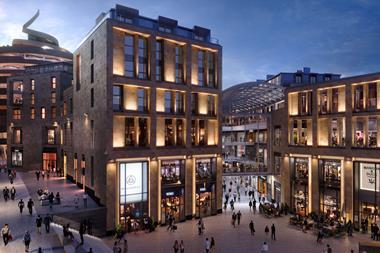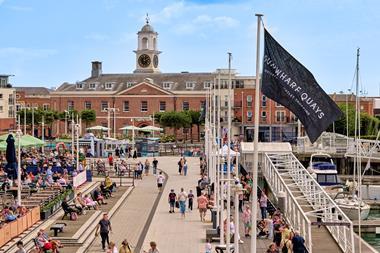The Northwest is a region of extremes. At one end of the scale some of the country’s top retail developments have sprung up here in the past few years. At the other, there are developers facing the unthinkable – having to scrap schemes altogether.
Retail development in the Northwest faces an unpredictable future as harsh business conditions take their toll. “A lot of the developers in the Northwest are young and ambitious,” says Modus director of development Tim Heatley. “We’ll all be struggling and we’ll all find it hard work. It comes down to how much banks trust you and it’s a worry for everyone.”
And in the third largest region by population – just shy of 7 million – there is plenty going on. The most important development has been the 1 million sq ft (929,000 sq m) of retail space that landed in Liverpool last year, bringing fresh retail brands, shopping space and vital employment. Since Grosvenor opened Liverpool One, the city has climbed the retail league tables and stemmed the city’s leak of shoppers to other parts of the region.
Elsewhere in the region, two other big schemes have also opened in the past 18 months – both by Modus. Last year the Manchester-based developer completed an extension to its Houndshill scheme in Blackpool, increasing the size to 400,000 sq ft (37,160 sq m), and in 2007 work was finished on the 500,000 sq ft (46,450 sq m) Grand Arcade in Wigan. Key schemes in the region, the fact that these centres opened so well let is a sign that demand for space is – in certain areas at least – very strong.
But the recent past is not the problem. As with retail development around the UK, the real challenges are yet to come. Between now and 2014 about 6 million sq ft (557,400 sq m) of new space is theoretically due to debut in the region, if all the pipeline schemes go ahead.
In truth, they won’t. Within the past year circumstances have taken a rapid turn for the worse and the whole complexion of the development industry has changed. Where once there was credit easily available, now securing new financing is hard, if not impossible. For developers that rely heavily on debt, this is very bad news.
“It’s all down to what’s viable,” says Grosvenor director Guy Butler, who oversaw the Liverpool One project. “If developments are viable they will go ahead. Viability is not as much about supply and demand but whether the banks will lend.”
Speaking about the national scene, Thorntons head of property Mike Barnett says: “What is frightening is that only 12 months ago, 11 million sq ft (1 million sq m) was planned to open in 2010. The towns where schemes are being put on hold are going to suffer considerably. It will probably take in excess of five years to get things going again.”
Barnett’s comments are probably more relevant to the Northwest than anywhere else. As a sign of how rapidly things have deteriorated, having just celebrated the opening of Houndshill almost fully let, Modus is now completely restructuring its business.
The news that it was selling a large chunk of its shopping centre investment portfolio two weeks ago is only the start of the company’s problems. What it now has to face up to is the cold reality of delaying and even totally suspending schemes until things improve.
With its financing problems clearly not going away, Modus has taken the difficult step of putting both of its present schemes in the Northwest, in Crewe and Warrington, under review until further notice. The company has admitted that the present state of the credit market means it might be years before the first spade breaks earth on either of these schemes.
“Crewe is under complete review,” says Heatley. “It’s gone back some way, probably about two or three years. We’re starting with a blank page again to establish if we want as much fashion space.”
And these schemes are no small matter. Totalling more than 1.2 million sq ft (111,480 sq m), both projects were due to bring a hefty amount of new retail space to the towns concerned.
ING Real Estate’s 500,000 sq ft (46,450 sq m) Northgate project has also ground to a halt. The scheme is different but the problem is the same: a lack of financing. Six months on from the original start date for construction not a single truck has rolled onto the site in Chester and ING Real Estate is seeking a new funding partner.
Also gathering dust is a site in Stockport, once earmarked for another mammoth scheme, after developer Lend Lease pulled out last August. The 1.5 million sq ft (134,705 sq m) Bridgefield project was to be the beginning of a rebirth for Stockport, which despite its affluent catchment lacks the retail it deserves. Now Stockport is left with only the slimmest of hopes that the work will begin any time soon.
The Northwest was dealt another blow two weeks ago with the news that the 320,000 sq ft (29,730 sq m) Centros Castle View scheme in Lancaster was to be called in following protests by English Heritage. Centros is now faced with the frustration of more delays and costs while the Government assesses the impact of the scheme.
Of course there are still schemes going ahead in the Northwest. If all goes to plan about 3.8 million sq ft (353,020 sq m) worth of retail space will be added to the region in the next five years. And the ones that are going ahead are looking in pretty good shape.
Next year Thornfield will open a 1.6 million sq ft (148,640 sq m) mixed-use scheme in Bury called The Rock. With 18 months to go, the developer is in a more comfortable position than most in the Northwest, having secured Marks & Spencer and Debenhams to anchor the scheme and with 200,000 sq ft (18,590 sq m) of the 500,000 sq ft (46,450 sq m) of retail space let.
And the other big project already on site, a 136,000 sq ft (12,635 sq m) extension to The Mall’s Blackburn shopping centre, is looking equally healthy. With key anchor tenants Primark, WHSmith and Peacocks already on board in the 240,000 sq ft (22,295 sq m) of retail space, it is due to open this autumn.
Fit to burst
What is so striking about the pipeline in the Northwest is the sheer scale of space involved. With delays to schemes in Lancaster, Warrington, Crewe, Chester and Stockport, the region now has a staggering 3.5 million sq ft (325,150 sq m) black hole in its pipeline for the coming years, with no immediate signs of anything coming along to save the day.
This highlights a big problem. During the past heady decade, developers around the country have been stretching themselves as far as they could. Plans were drawn up with little thought given to what might happen when the bubble burst. Now it has, the audacity of some of those schemes is apparent.
Savills Manchester director Paul Wright says: “Over the past eight to nine years the market has been pushed beyond reality to the point that some schemes are now being completely relooked at. We’ll start to see more phasing of schemes and much more realism in terms of the size of a development.”
So while it is painful for developers such as ING Real Estate and Modus to have to admit, the crunch might actually end up saving them from opening shopping centres in catchments that could not sustain them.
The state of the property market in the Northwest can in fact be summed up quite easily. Schemes fall into three categories: those that have just been completed, those that are under way and those that are yet to get on site.
In the first case, schemes like Houndshill that are up and running opened just in time. With enough retailers still eager to take new space, those that launched in the past two years were given just enough time to get settled before things really took a turn for the worst.
For those developers on site, there is no choice but to press ahead. In most cases the funding to see the projects through should already be in place or will be relatively easy to come by and the only real challenge might be to get them let.
The developers in the last category face a tough time. Once funding is gone it is difficult to see how it can be retrieved, at least in the near future. But, as Heatley argues, it is a chance to go back to the drawing board and, if a scheme was a little over-ambitious the first time around, the opportunity to put it right is now here.
“Without a doubt, unless ground is broken or they’re well progressed on some of the less strong developments they’re going to be hung out to dry,” says CACI associate director Daniel Parr. “Where we’ve seen particular activity and success is where the ground’s been broken and it’s got to be delivered, or where the developer has thought about the impact on the town.”
As in the wider market, things are far from easy in the Northwest. With masses of retail space now under threat the pipeline is going to be hard to forecast for some years to come.


























No comments yet